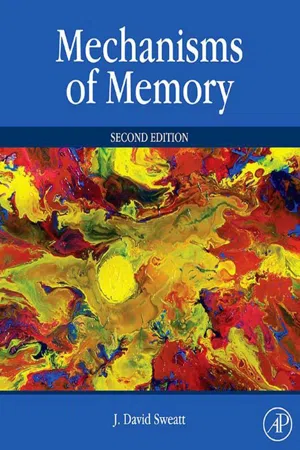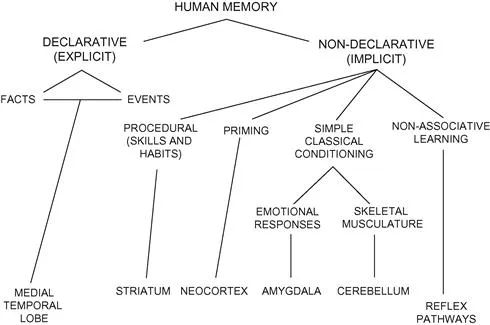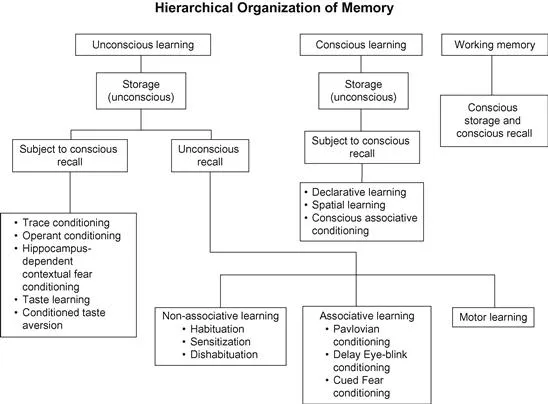I. Introduction
Multiple Memory Systems
J. David Sweatt, acrylic on canvas, 2008–2009
Knowledge is power and learning is the tool we use to get it. For that reason humans have evolved extremely sophisticated mechanisms for learning new information and storing it for subsequent recall. This book will be a description of recent laboratory discoveries that have begun to scratch the surface of the amazingly complex phenomenon of learning and memory, focusing on their cellular and molecular bases.
An understanding of the cellular and molecular basis of learning and memory of course requires a firm foundation in understanding the behavioral processes these mechanisms subserve. This first chapter serves as an introduction to the basics of learning and memory, its theory and terminology. This will provide you with the fundamental terms most psychologists use to describe the types and forms of learning and memory that we will be discussing throughout the book.
What is learning? Before we can begin to effectively discuss categorizing types of learning and memory, it is useful to define both of the terms we will be using extensively throughout this book: “learning” and “memory.” Both of these terms are so widely used and implicitly understood that there is a great temptation to say “learning is when you learn something and memory is when you remember it.” This type of definition obviously is not going to take us very far.
Upon serious reflection it becomes clear that neither “learning” nor “memory” is easy to define, and indeed learning and memory psychologists continue to debate these definitions to this day. In this book we will define learning as: the acquisition of an altered behavioral response due to an environmental stimulus. In other words, learning is when an animal changes its behavior pattern in response to an experience. Note that what is defined is a change in a behavior from a pre-existing baseline. Don’t get confused: learning is not a response to an environmental stimulus, but rather is an alteration in that response due to an environmental stimulus. An animal has a baseline response, experiences an environmental signal, and then has an altered response different from its previous response. This is learning (see Figure 1).
Figure 1 Definitions of learning, memory, and recall.
Memory is defined as the storage of the learned item, which of course must be subject to recall by some mechanism.
These definitions are functional definitions that lend themselves to experimental application. An experimentalist has to be able to observe something (and ideally measure it) in order to be able to test a hypothesis. The definitions of learning and memory that are used in this book derive directly from the experimentalist mindset. This practical orientation is both a strength and a weakness for the definitions—their ready application in practice leads to limitations for their use in theory.
For example, one criticism of this definition of learning is that it is too narrow. If someone learns my name and stores it as a perfectly legitimate memory, that learned item may never be manifest as an altered behavioral output on their part. This is a completely valid theoretical criticism and a limitation to the definition. The rebuttal to this argument is that in order for one to ever prove that such a memory exists, one would have to demonstrate an altered behavioral output on the part of the person involved. For example, an experimenter would have to have them respond with “David” instead of “I don’t know” when they showed them my picture. Nevertheless, it is important to remember that this definition is based in experimentation, not theory.
At the other end of the spectrum is the criticism that the definition is too broad. It certainly covers many types of alterations in behavior, such as simple sensitization and habituation, which most people would not consider as “real” learning (this is illustrated in Box 1, for example). Nevertheless, a considerable body of literature is available indicating that many simple forms of behavioral modification qualify as learned responses, and most researchers in the field agree with this. These forms of simple, non-associative learning are described in Section III of this chapter, and in more detail in Chapter 3 of this book.
Box 1 Learning in a Plant? “Sensitization” in the Venus’ Flytrap
Our functional definition of learning is: a change in an animal’s behavioral responses as a result of a unique environmental stimulus. This broad definition is useful in that it encompasses various non-associative forms of learning such as sensitization and habituation, but the breadth of the definition can be criticized. This can be illustrated by consideration of “sensitization” in the Venus’ flytrap plant.
Although plants are not thought of expressing behavior in the same sense as animals, plants can and do respond to environmental stimuli. We are all familiar with the phototactic responses of plants as they turn to follow the sun, foliage changes in response to cooling weather, and the nocturnal closing of certain flowers, just to name a few simple examples. However, these types of responses are really more akin to reflexive, non-learned behaviors in animals.
One intriguingly complex, multi-component response of a plant to an environmental stimulus is exhibited by Dionaea muscipula, commonly known as the Venus’ flytrap. This carnivorous plant, indigenous to the peat bogs of the Carolinas in the southeastern United States, supplements its nutrition by capturing and digesting insects. Insects are trapped by Dionaea when they land in one of the plant’s V-shaped leaves, which closes on the hapless victim like a miniature steel bear trap.
It is the triggering mechanism for closure of the trap that warrants our attention. Each half of the V-shaped trap has on its inward facing surface three trigger hairs. Mechanical stimulation of these hairs is what elicits closure of the trap. To eliminate “false alarms,” Dionaea has evolved a mechanism whereby stimulation of a single trigger hair is insufficient to cause closure of the trap. Two hairs must be stimulated in succession (or simultaneously) to trigger a trapping response. Thus, in one circumstance stimulating a particular trigger hair will give no response, whereas depending on recent history stimulating the same trigger hair will in another instance give trap closure. This is clearly an example of an altered response that depends on a prior environmental stimulus. In a sense, the mechanical stimulation of the first trigger hair could be viewed as analogous to “sensitizing” the plant, in order that it respond to the mechanical stimulation of the second hair. Venus’ flytrap photograph by Muriel Weinerman.
A. Categories of Learning and Memory
This broad, umbrella-like definition of learning covers so many different types of behavioral modifications that some sort of organizing principle and attendant nomenclature are called for. We will use an organizational framework developed and pro-mulgated by Larry Squire and Eric Kandel (1–3). As a starting point we will use their system, and I would be remiss if I did not credit their many significant and influential contributions in this area.
In this scheme human memory is typically divided into declarative and non-declarative types, also known respectively as explicit and implicit memory (see Figure 2). This type of system, subdividing memory into several separately identified components, distills the modern concept of multiple memory systems. It is now clear that different anatomical structures in the brain are involved in different types of memory formation. Moreover, the different systems can operate as parallel processors, operating independently. This allows multi-tasking, with conscious and unconscious memory systems operating simultaneously and increasing the overall “memory throughput” of the CNS. Figure 2 briefly summarizes the major subdivisions of human memory, along with the associated known areas of the CNS that are involved in those specific types of memory. We will discuss most of the major subdivisions listed in Figure 2 in greater detail later in this chapter, and in Chapter 3 of this book.
Figure 2 Subdivisions of human memory and associated brain regions. Human memory is typically divided into declarative and non-declarative types, also known as explicit and implicit memory, respectively. In addition to various types of memory described in the text, priming is also listed. Priming is unconscious memory formation. An example of priming is if one hears or reads a word, for a period of time afterward one is more likely to use that word in conversation or in a word completion task. This occurs even if no conscious memory for having heard the word is formed.
Chart adapted from Milner, Squire, and Kandel (13).
The multiple memory systems concept is important and soundly based on functional neuroanatomy. However, a different, cognitively based framework is also useful to consider. This additional system is based on whether different types of learning and memory are consciously or unconsciously processed. Thus, using this system one can divide learning into two broad classes—unconscious learning and conscious learning. For the purposes of this framework we also introduce a “recall” term (see Figure 3), and apply conscious and unconscious to it as well. Thus, any type of memory (with one exception, see below) falls into one of four categories: unconscious learning with unconscious recall; unconscious learning subject to conscious recall; conscious learning subject to unconscious recall; and conscious learning subject to conscious recall. Specific examples of each category are listed in Figure 3 for illustrative purposes, and for the rest of this chapter and in Chapters 2 through 6 we will cover many specific examples in each category.
Figure 3 Hierarchical organization of memory. Short-term and long-term memory is subject to being learned by either conscious or unconscious processes. Similarly, memory can be recalled either consciously or unconsciously. Many forms of simple learning such as motor learning, simple associative conditioning, and non-associative learning can be learned and recalled unconsciously. More complex forms of learning typically involve conscious processes. Short-term working memory is listed as a separate category because it is essentially entirely conscious and not stored for more than a few seconds.
The nomenclature summarized in Figure 3 emphasizes that any given memory event is comprised of three components: learning; storage; and recall. An item or event is learned, stored for some period of time, and recalled. Highlighting these three components is necessary, because each corresponds to a distinct molecular and cellular set of events.
It is also important to note that the category for the learning, memory, and recall of a specific bit of information is not static over time, but subject to change. This can be illustrated by considering the learning and recollection of a phone number that becomes familiar with repetition. One first looks up the number and consciously stores and recalls the number. Over time one repetitively punches in the number and it is subject to being learned unconsciously as a motor pattern, and recalled unconsciously in the same way. This is one example of how the same bit of information, over time, can be subject to conscious learning, unconscious learning, conscious recall, and unconscious recall.
Finally, note that storage is unconscious in this model. This emphasizes the underlying nature of the storage mechanisms—they do not require ongoing conscious rehearsal. This has critically important implications concerning the cellular and molecular ...





